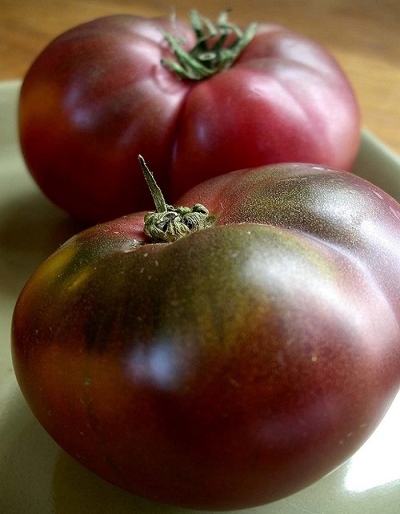
- Authors: Kudryashov A.V.
- Year of approval: 2017
- Category: grade
- Growth type: indeterminate
- Appointment: fresh consumption
- Ripening period: mid-early
- Ripening time, days: 110-115
- Growing conditions: for open ground, for film greenhouses
- Marketability: high
- Bush size: tall
For lovers of unusual tomato varieties, many types are offered, including dark-colored tomatoes containing a huge amount of vitamins. These include the mid-early variety Black Sugar, which is productive both in the greenhouse, and in the greenhouse, and in the garden bed.
Breeding history
Black sugar is an exotic plant developed by the Russian scientist A.V. Kudryashov in 2016. A year later (in 2017) the nightshade crop was approved for use and joined the ranks of the State Register of Breeding Achievements of the Russian Federation. Recommended for growing tomato in all climatic zones of the country. The variety is productive, growing both in the garden and in greenhouses.
Description of the variety
Varietal tomato is a tall shrub of an indeterminate type. As a rule, the bushes grow to a height of 230 cm. The plant is characterized by a moderate green foliage, medium branching, a strong central stem, a powerful root system that goes deep into the soil, and simple inflorescences. In each fruit cluster, from 4 to 5 large berries are tied.
The bushes require the formation of 1-2 stems, the regular removal of extra stepsons and the obligatory garter to the support, since the branches can break off under the weight of weighty tomatoes. The purpose of the vegetable is salad, so it is eaten fresh, widely used in cooking, processed into drinks and sauces. The variety is not suitable for whole-fruit canning due to the size of the tomatoes.
The main qualities of the fruit
Tomatoes Black sugar is an unusual representative of large-fruited nightshades. A vegetable grows up to 250-300 grams. The shape of the fruit is rounded with a noticeable ribbing of the surface. A ripe giant tomato is covered with a dark brown color, and at the stage of technical maturity, the tomato is green with a darkened spot at the stalk.
The peel of the vegetable is shiny, thin, but strong enough. The tomato is endowed with crack resistance, good transportability and long shelf life. Only overripe tomatoes can be prone to cracking.
Taste characteristics
This vegetable stands out not only for its beautiful color, but also for its excellent taste. The tomato pulp is moderately dense, sugary and juicy. The taste of the vegetable is sweetish, with a slight sourness. The pulp contains about 5% sugar. The balanced taste is harmoniously combined with the sweet-dessert aroma. The pulp of the vegetable is rich in antioxidants, lycopene and vitamin C.
Ripening and fruiting
The tomato is medium early. From germination of sprouts to ripe berries on the bushes, 110-115 days pass. The active phase of fruiting occurs in July-August. The tomatoes spice together in unison, although the fruiting period itself is slightly extended.
Yield
The crop yields are high. On average, observing all the rules for caring for a plant, about 20-21.5 kg of delicious tomatoes can be grown per 1 m2. Summer residents note that they collect a whole bucket of tomatoes per 1 m2 per season.
The timing of planting seedlings and planting in the ground
A vegetable crop is planted through seedlings. Sowing seeds is carried out at the end of February, in March. Germination occurs after 6-8 days. To speed up the sprouting process, you can cover the boxes with seedlings with glass or polyethylene. At the stage of appearance of 2-3 leaves, the bushes dive into individual containers. In the process of growing, do not forget about watering and feeding.A week before the transfer of plants, they are hardened, which will allow them to quickly adapt to new growing conditions.
Bushes are transplanted at the age of 55-60 days. The planting is carried out in the middle of May, and in the greenhouse two weeks earlier.

Growing tomato seedlings is an extremely important process, because it largely depends on whether the gardener can harvest at all. All aspects must be taken into account, from seedbed preparation to planting in the ground.
Landing scheme
The density and arrangement of the bushes are very important when planting. It is recommended to plant 3 bushes per 1 m2. The optimal layout for planting is 70x40 cm.

Growing and care
Plants are absolutely unpretentious to care for, but a little demanding on the place of growth and the quality of the soil. The soil should be fertile, loose, moisture and air permeable, and have a neutral alkaline balance. When planting tomatoes in the garden, do not forget that the area should be abundantly illuminated by the sun.
Comprehensive care consists of a number of measures: watering with settled water, fertilizing, weeding the soil, shaping, tying and pinching bushes, controlling moisture if tomatoes grow in a greenhouse, as well as protecting against fungus and insects.




A plant needs different micronutrients at each stage of growth. All fertilizers can be divided into two groups: mineral and organic. Folk remedies are often used: iodine, yeast, bird droppings, eggshells.
It is important to observe the rate and period of feeding. This also applies to folk remedies and organic fertilizers.
Disease and pest resistance
The variety has sufficient immunity to resist standard tomato diseases - tobacco mosaic virus, fusarium wilting, apical and root rot. It is also worth noting that due to its early maturity, the variety bypasses late blight.


Resistant to adverse weather conditions
The vegetable culture has excellent endurance and resistance, so the plant perfectly adapts to climatic conditions, easily tolerates drought, heat, and sharp temperature jumps. The only thing a culture is susceptible to is excessive moisture, dampness and drafts.

























































































